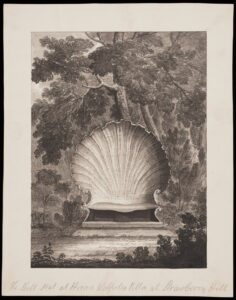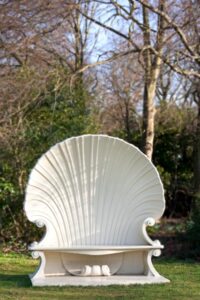Seated in a Shell
Written by Nitasha Giran, Collections Assistant
‘This shell was one of Mr. Walpole’s favourite inventions – for Strawberry Hill was crammed with inventions and contrivances. It was a seat in the form of a huge bivalve of a species not easily recognized, which generally elicited a vast amount of wonder and admiration from his visitors’. – Eliot Warburton, Memoirs of Horace Walpole and his contemporaries, 1851, p. 461
Horace Walpole designed Strawberry Hill with two contrasting counterparts: a gloomy house and a cheerful garden. Although much attention is given to the stately interiors of his ‘little Gothic castle’, it is worth reminding that Walpole carefully designed the garden alongside (and even before) he developed the house.
As a result, Walpole was particularly fond of a commission he made for his garden–a monumental Shell Seat. A cavernous half-clamshell, 7 x 7.5 x 4 feet, the Shell Seat was originally in the corner of the garden facing the River Thames. In a surviving letter, Walpole mentions that the Duchesses of Hamilton and Richmond and Lady Ailesbury, could all sit comfortably together on the shell.
Although Walpole was not fond of naturalia himself, his mother was a noted shell collector. She is depicted with some of her collection in the portrait Robert and Lady Walpole by Eccardt and Wootton in a Grinling Gibbons Frame (FactumArte replica currently hung in the Blue Bedchamber). He also likely encountered the height of a ‘shell mania’ in Paris when he embarked on the Grand Tour in 1739. Perhaps this inspired Walpole to employ artist Richard Bentley to create a Rococo piece of decorative art. Unfortunately, the original seat has not survived but was likely sold off in the posthumous sale of Strawberry Hill’s contents in 1842.
Today, a faithful replica of the Shell Seat can be found in Strawberry Hill’s garden. The restoration of the property (completed in 2010) lent an opportunity to return a shell seat to the property in an attempt to restore Walpole’s garden as much as his house. Using only two surviving eighteenth century drawings as the source, the Shell Seat was constructed through a combination of eighteenth century and modern building techniques. It is carved from oak and painted white (however not using lead-based paint as the original had). The long complex process of recreating the seat shed light on why it must have taken Bentley four years to build the original. The concave back of the shell proved particularly difficult to shape from oak without splitting the planks. Layering laminated strips of oak over a dome eventually provided a solution. Another instance of modern intervention was in imagining what the side and back views of the seat would have been as the reference drawings only provided a partial view.
The finished replica Shell Seat now sits only one hundred metres away from the house and facing the property. It was not possible to return the seat to its original location because a summer house now stands in its place–an addition made by the Stern family who purchased Strawberry Hill in 1883. Nonetheless, the replica continues to frame visitors who choose to use it for a moment of contemplation–much like it certainly did for many visitors in Walpole’s time.

Yale drawing, forward facing: The shell seat at Horace Walpole’s villa at Strawberry Hill. Unknown artist c. 1822. Lewis Walpole Library, Yale University.

The Shell Seat replica, Strawberry Hill House Garden. Photo: Matt Chung
Yale drawing (main image top): Design for a seat at Strawberry Hill. Richard Bentley c. 1754. Lewis Walpole Library, Yale University.